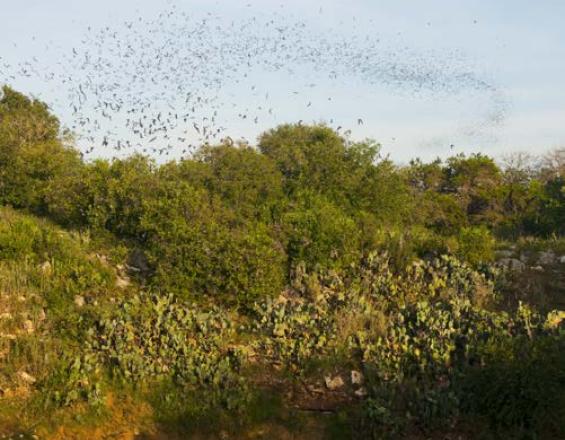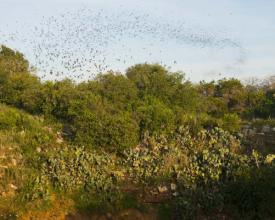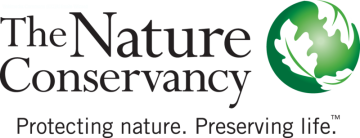
Se crea la reserva de la cueva de Bracken gracias a una evaluación sanitaria

La reserva de la cueva de Bracken alberga la mayor colonia de murciélagos del mundo, unos 20 millones de murciélagos mexicanos de cola libre(Tadarida brasiliensis). Los planes para construir un complejo residencial en una extensión de 1.521 acres adyacente a la boca de la cueva suponían un grave riesgo para la fauna y la población humana potencial. Preocupado por el acuífero cercano, pero limitado por la falta de leyes de zonificación en la zona, el gobierno local encargó un informe sobre los posibles riesgos para la salud pública de la urbanización. El informe destacaba la preocupación por la exposición humana a diversos patógenos, tanto por la exploración de la cueva como por la presencia de murciélagos en torno a las nuevas residencias. Para proteger a los murciélagos y a las poblaciones humanas, defensores de diversos sectores, como conservacionistas, expertos en salud, gobiernos municipales y del condado, y la empresa pública de suministro de agua, se unieron para comprar la extensión de terreno. En 2014, la propiedad se convirtió oficialmente en la Reserva de la Cueva de Bracken, protegiendo a perpetuidad esta zona esencial para la salud medioambiental, animal y humana.
Contexto
Défis à relever
Antes de que el equipo adquiriera la zona de Galo para preservarla, había planes para construir 3.500 viviendas y una comunidad residencial en expansión. Ello habría provocado importantes alteraciones medioambientales con repercusiones en cascada sobre toda la fauna circundante, en particular la colonia de murciélagos y la población de curruca carrillera. La población humana estaría expuesta a diversos riesgos para la salud, tanto por los vuelos de los murciélagos como por la inevitable exploración humana de la cueva de Bracken. El impacto potencial del proyecto en un acuífero cercano planteaba otros problemas ambientales, sociales y sanitarios. La zona de Texas en la que se encuentra la zona de Galo carece de leyes de zonificación, por lo que las jurisdicciones locales no tienen autoridad para intervenir y alterar los planes de urbanización. Sin un mecanismo legal específico disponible para detener el desarrollo residencial, el equipo determinó que sólo mediante la compra de la tierra ellos mismos podrían prevenir los impactos ambientales y de salud negativos del desarrollo.
Ubicación
Procesar
Resumen del proceso
Cuando se utiliza la perspectiva de "Una sola salud" para abordar cualquier reto, es esencial trabajar eficazmente con sectores que antes estaban aislados. A menudo, el bienestar humano no se considera parte de la planificación de la conservación, y los servicios ecosistémicos que proporcionan los entornos naturales intactos suelen ser pasados por alto por el campo de la salud humana. Una evaluación "Una Salud" brinda la oportunidad de salvar las distancias y reunir a partes interesadas con motivaciones diversas y un objetivo común. La asociación desarrollada para adquirir la extensión de Galo y crear la Reserva de la Cueva de Bracken fue posible gracias a un informe que describía específicamente la intersección entre la presencia de la colonia de murciélagos y la salud y el bienestar de las comunidades humanas circundantes.
Bloques de construcción
Colaboración intersectorial
Cuando se anunció que el trazado de Galo se convertiría en una zona residencial, preocupó a partes de múltiples sectores. Los conservacionistas y los científicos especializados en murciélagos consideraron que el plan creaba un conflicto entre el hombre y la fauna donde antes no lo había, lo que suponía una amenaza para la salud y el bienestar tanto de la naturaleza como de las poblaciones humanas. El gobierno local, en particular el concejal Ron Nirenberg, había expresado su preocupación por el plan, centrada principalmente en el acuífero cercano y el agua potable de la región. Para evaluar a fondo las principales contrapartidas del plan de desarrollo residencial, el gobierno local dio el paso de unificar a diversos socios y sus intereses transversales. Al encontrar un terreno común en el objetivo final de preservar la zona que rodea la Cueva de los Murciélagos de Bracken, las partes interesadas de diversos sectores pudieron transformar sus preocupaciones individuales en un interés mutuo a gran escala.
Factores facilitadores
Aunque el grupo de partes interesadas que se reunió para comprar la zona de Galo, entre las que había grupos con intereses anteriormente contrapuestos, tenía motivaciones distintas, su apertura a la colaboración les permitió encontrar un terreno común. Al reconocer su interés mutuo e identificar los puntos de intersección de sus preocupaciones, se desarrolló una asociación y se alcanzó un objetivo compartido.
Lección aprendida
Todas las partes implicadas en este proyecto tenían sus propias preocupaciones respecto a la urbanización prevista en los alrededores de la cueva de los murciélagos de Bracken. Aunque cada uno de los problemas, como la seguridad del agua, la conservación de la fauna y los riesgos para la salud humana, era preocupante en sí mismo, ninguna de las partes interesadas por sí sola podía crear un argumento lo bastante sólido como para impedir que la urbanización siguiera adelante. El gobierno local reconoció el valor de la colaboración y creó un espacio para que se unieran sectores hasta entonces aislados. Al crear asociaciones donde antes había lagunas, sobre todo entre los sectores del medio ambiente y la salud humana, se hizo posible la solución más amplia de comprar el terreno y crear una reserva.
Una evaluación sanitaria
Para captar plenamente los riesgos para la salud que entrañaría el desarrollo residencial de los terrenos que rodean la cueva, se llevó a cabo una evaluación de "Una Salud", un análisis en profundidad de las conexiones intrínsecas entre la salud de las personas, los animales y el medio ambiente de la zona. Dirigida por EcoHealth Alliance, puso de relieve la ecología de los murciélagos y las interacciones con su entorno, llamando la atención sobre la singularidad de esta colonia y las diversas formas en que se solaparían con las residencias humanas. Este informe se utilizó para movilizar a una gran coalición de partes interesadas: al poner de manifiesto los riesgos a los que se enfrentarían los seres humanos, personas que antes no estaban implicadas se unieron al esfuerzo para impedir que el proyecto siguiera adelante. El enfoque "Una sola salud" amplió la audiencia potencial, generó más atención y fondos, y condujo al éxito allí donde un enfoque aislado habría fracasado.
Factores facilitadores
El éxito de la Evaluación Única de la Salud fue posible gracias a la ampliación de las preocupaciones más allá de las cuestiones recogidas en la evaluación estándar llevada a cabo para el desarrollo. Las partes interesadas se centraron en la seguridad humana, animal o medioambiental, pero el reconocimiento de que estas cuestiones eran más importantes cuando se consideraban conjuntamente permitió realizar una evaluación más completa.
Lección aprendida
Ampliar la evaluación de impacto tradicional para incluir la perspectiva de "Una sola salud" permite comprender mejor tanto los riesgos potenciales que plantea una urbanización como las posibles ventajas de preservar el terreno. Cuando un sistema natural (y la vida silvestre que alberga) no tiene suficiente valor social o financiero por sí mismo para impedir la invasión humana, destacar las protecciones de la salud humana que proporciona puede otorgarle el valor adicional necesario para obtener protección. El enfoque "Una sola salud" llama la atención sobre servicios ecosistémicos que hasta ahora habían pasado desapercibidos, como la regulación de enfermedades y la reducción del riesgo de propagación. Otros servicios que prestan los murciélagos, como la polinización, la dispersión de semillas y el control de vectores, aportan beneficios adicionales para la salud humana que también pueden tenerse en cuenta en futuras evaluaciones. Un grupo más amplio y diverso de partes interesadas en la protección de la naturaleza hace que los esfuerzos de conservación sean más factibles y fructíferos.
Impactos
El impacto de esta solución va más allá de la mera conservación de la fauna y capta los diversos efectos positivos del planteamiento "Una Salud" en la planificación del desarrollo territorial. La fauna de la región, incluidos los 20 millones de murciélagos que viven en la cueva Bracken y la curruca carrillera(Setophaga chrysoparia), en peligro de extinción a escala federal, viven ahora protegidos de la invasión de las poblaciones humanas. Las organizaciones sin ánimo de lucro dedicadas a la conservación gestionan ecológicamente la región mediante quemas controladas que garantizan la salud del ecosistema. Al impedir la construcción de 3.500 unidades a lo largo de la zona de Galo, se protegió a decenas de miles de posibles residentes humanos de la inevitable exposición a patógenos que circulan entre la población de murciélagos. Como demuestran los efectos de anteriores episodios de propagación, como el SARS, el Zika y el COVID-19, la protección de la salud humana que proporciona la reserva de Bracken Cave no se limita a las personas que habrían vivido en la trayectoria de vuelo de los murciélagos. Comunidades tan cercanas como la vecina y potencialmente tan lejanas como la otra punta del mundo han evitado las consecuencias de una enfermedad zoonótica que salta de la población de murciélagos a las personas.
Beneficiarios
La salud y el bienestar de las comunidades humanas circundantes
Colonia de murciélagos mexicanos de cola libre
Población de curruca carrillera
Ecosistema circundante
Objetivos de Desarrollo Sostenible
Historia
Las evaluaciones de impacto ambiental tradicionales no suelen examinar los riesgos de transmisión de enfermedades zoonóticas que pueden derivarse del mayor contacto entre el hombre y la fauna salvaje creado por el proyecto de desarrollo. La evaluación de impacto ambiental y sanitario iniciada por la ciudad de San Antonio, en respuesta a un plan para crear un barrio residencial en terrenos adyacentes a Bracken Cave, fue realmente notable en el sentido de que, que yo sepa, fue uno de los primeros casos en que un municipio local fue más allá de las evaluaciones de impacto ambiental tradicionales al encargar un estudio de los posibles efectos sobre la salud de las enfermedades zoonóticas que se derivarían del desarrollo. En concreto, el departamento de salud de la ciudad quería saber si aumentaría el riesgo de exposición a patógenos zoonóticos, como la rabia, como consecuencia del contacto con murciélagos u otros animales salvajes que viven en la cueva y sus alrededores. La cueva Bracken alberga la mayor colonia de murciélagos del mundo. Estos murciélagos son ecológica y económicamente importantes porque consumen toneladas de insectos que son plagas agrícolas. Los murciélagos también son reservorios del virus de la rabia, que es mortal en las personas, así como en perros y gatos, cuando no están vacunados. Me gustó que, además de las cuestiones sanitarias que me plantearon, el Ayuntamiento de San Antonio colaborara con una organización local de conservación de murciélagos y otras organizaciones ecologistas para conocer a fondo las posibles amenazas para la fauna local. Para mí, este era un ejemplo magnífico de la ciencia y la política de Una Salud en acción. Tras pasar tiempo observando los patrones de vuelo de los murciélagos y entrevistando a los residentes de las comunidades cercanas a la cueva, me quedó claro que las personas y sus mascotas tendrían muchas posibilidades de entrar en contacto no solo con los murciélagos, sino también con otros animales como mapaches, zorrillos y zorros que se alimentan de los murciélagos en la boca de la cueva y que también son portadores de la rabia. La combinación de las evaluaciones de impacto sobre la conservación, el medio ambiente y la salud llevadas a cabo por la ciudad proporcionó pruebas importantes de que el desarrollo era problemático. La capacidad de Bat Conservation International y de Conservación Internacional para recaudar dinero y comprar el terreno directamente para protegerlo del desarrollo fue sin duda una victoria para la conservación y la salud pública. Para mí, la iniciativa de la ciudad de San Antonio de tener en cuenta las consecuencias para la salud de un mayor contacto entre el hombre y la fauna salvaje fue una victoria para "Una Salud" y un modelo de enfoque para el desarrollo a escala mundial.



